
All images © by Roberto Piperno, owner of the domain. Write to romapip@quipo.it.
Notes:
Page revised in August 2021.

All images © by Roberto Piperno, owner of the domain. Write to romapip@quipo.it.
Notes:
Page revised in August 2021.
 - Avignon: Other Monuments
- Avignon: Other MonumentsYou may wish to see an introductory page to this section or the main page on the town first.
When visiting Avignon one has to bear in mind that most churches and palaces have been heavily restored or even entirely rebuilt, yet it is a pleasure to stroll around.
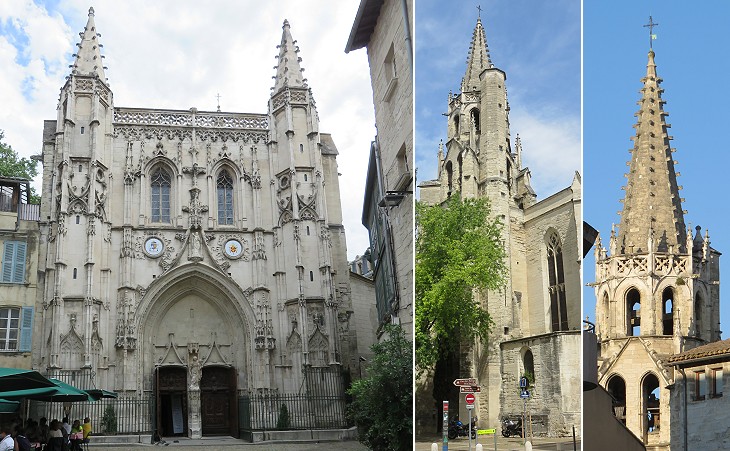
Saint-Pierre: (left) façade; (centre/right) lantern tower
From the opposite hills this city seems a
forest of steeples, the bells of which are never
at rest; by day and night scarce a minute
can be counted undisturbed by some bell or
other, either rousing the monks and nuns to
their duty in the choir, or giving the more
welcome summons to their repasts.
Henry Swinburne - Travels through Spain in the Years 1775 and 1776 to which is added a Journey from Bayonne to Marseille - 1787 Edition
The church of St Pierre has a richly florid front built in 1512 nearly in the Perpendicular style, but mutilated.
John Murray III - Hand-book for Travellers in France - 1843
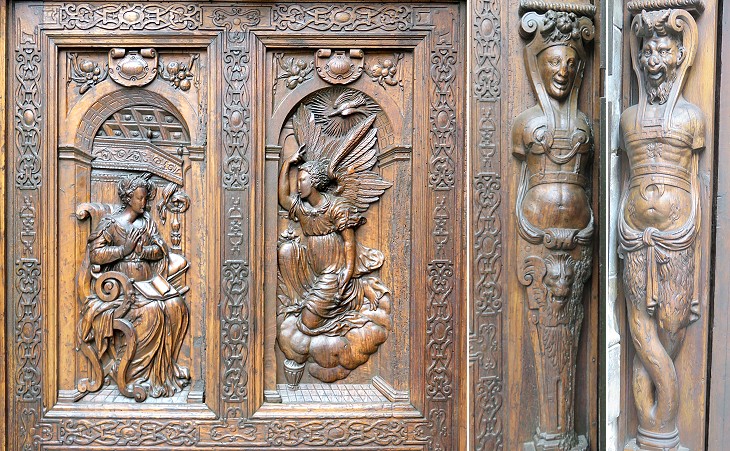
Saint-Pierre: doors; another detail can be seen in the image used as background for this page
The church was built in 1358, but the façade was completed in 1512-1524 and its fine walnut doors were made in 1551 by Antoine Volard, a woodcarver of Avignon. They mix religious themes with an elaborate Italian Renaissance decoration based on mythological creatures, e.g. at Palazzo Farnese di Caprarola. You may wish to see the Renaissance wooden choir of the Cathedral of Saint-Bertrand-de-Comminges.
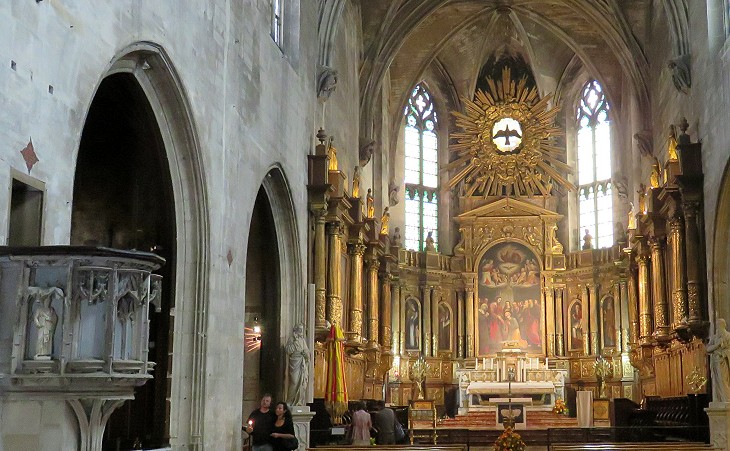
Saint-Pierre: interior
The cruel and terrible effects of the Revolution are every where visible in Avignon; the monasteries, the chapels and churches built with more magnificence than taste in the fourteenth century have been destroyed with the monuments which they enclosed.
William Coxe - Galignani's Traveller's Guide Through France -1819
The bare interior emphasizes the XIVth century Gothic structures of the church. In 1659 François de Royers de La Valfenière, a local architect who most likely visited Rome in his youth, designed a Baroque wooden gilded choir which escaped destruction during the French Revolution when Avignon was annexed to France; it was most likely dismantled and reconstructed later on.
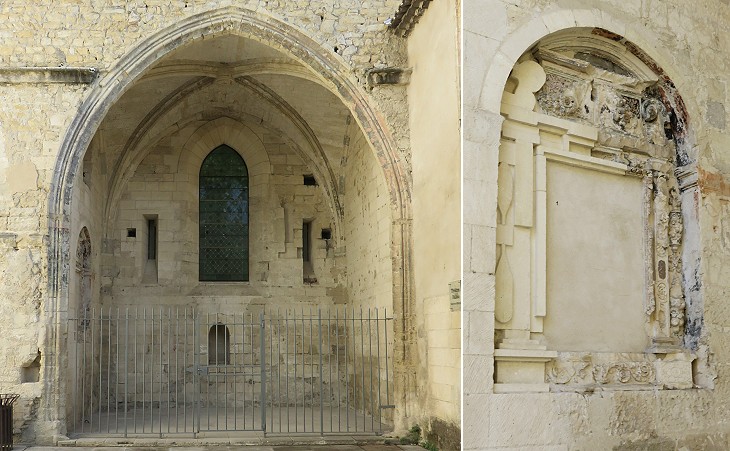
(left) Chapel of Laura, a past must-see of Avignon; (right) decorated niche on the wall
But for nothing
I more admired it than the tomb of Madonna Laura, the
celebrated mistress of Petrarch.
John Evelyn's Diary and Correspondence in 1644
The church of the Cordeliers is noted for the
boldness and loftiness of its roof, but much
more for the tomb of Petrarch's Laura, who
during her life, and after her decease, received
the tribute of his muse in more copious numbers than were ever inspired by any ancient
or modern fair one: he sang her charms,
and his love, in four hundred songs or sonnets. (..) Petrarch is classed by the Italians in
the first rank of poets; (..) so greatly do his merits
depend upon the manner in which he has
clothed his thoughts, that it requires great
habit of the Italian tongue to feel their value. (..) Laura and her husband,
Hugh de Sade, rest in an obscure corner of
the church, under a monument distinguished only by an obliterated scroll, and a mullet,
which was the arms of the family. Swinburne
Laura's tomb described by Arthur Young as nothing but a stone in the pavement with a figure engraved on it partly effaced surrounded by an inscription in Gothic letters and another on the wall adjoining with the armorial of the family de Sade, has entirely disappeared having been broken open and the contents of the tomb scattered by the Revolutionists. Murray
I sat down and I endeavoured to recall the history of Petrarch's love. I could not feel very romantic for I felt that there was far more in this affair to reprehend than to admire. There can be no question that Petrarch was a distinguished poet and scholar and that judging from the brilliancy of his genius he is entitled to a high rank among those who were considered the ornaments of the fourteenth century. But his moral character is not without dark shades although he was regarded religious according to the fashion of the age in which he lived. He observed fasts, bequeathed money to the church and revered saints and relics. But all this time he was evidently a voluptuous character. (..) It appears that one morning during Passion week in 1327 he went to the chapel of St Clara where he saw for the first time the beautiful Laura. She was the daughter of the Chevalier Audibert Noves, an old Provencal family and had been already married two years to young Hugh de Sade, a descendant of a distinguished family in Avignon. She is represented as being at that time full of youthful beauty and grace and possessing uncommon brilliancy of intellect. Petrarch was at once fired with a passion that seemed as violent as it was lasting. He sought to win her from the path of duty and to lead her to reciprocate his affection. According to his testimony though Laura sometimes favoured him with a smile or a kind word she always kept him at a distance and never in the slightest instance forgot her character or her honour. But evidently she was willing to receive his admiration and it is no great matter of surprise therefore that we read of the domestic trouble which she suffered from the ill humour of her husband. In our view Laura knowing as she did the nature of his attachment would have appeared far more lovely had she uniformly frowned upon Petrarch and barred him from all intercourse with herself and family. Petrarch it seems often resolved to tear himself away from her. He travelled into other countries and mingled in the bustle of the world, but her image still followed him. He then tried the influence of seclusion and solitude to calm and subdue his passion but it only burned with a brighter flame amid the hills and woods of Vaucluse. I cannot ascertain however that with all his learning and study he ever came to the conclusion to which every page in the Bible would have led him that his love for Laura was sinful and that to heaven he must lift his eye for grace and strength to vanquish it. He is gone and Laura too to the judgment bar where the principles of the Bible will be the only standard by which public opinion is formed.
Reverend John Alonzo Clark - Glimpses of the Old World - 1840
Clark (1801-1843) was a preacher in the years of the Second Great Awakening, an evangelical movement which spread across much of the U.S. He represented the evangelical wing of the Episcopal church, and his sermons reflected the evangelical emphasis on the inherent sinfulness of man, the acceptance of Christ as Redeemer, and the neccesity of conversion through faith. He did not realize that Laura was Petrarch's literary muse and that they likely never met or spoke from the moment Petrarch saw her on Good Friday.
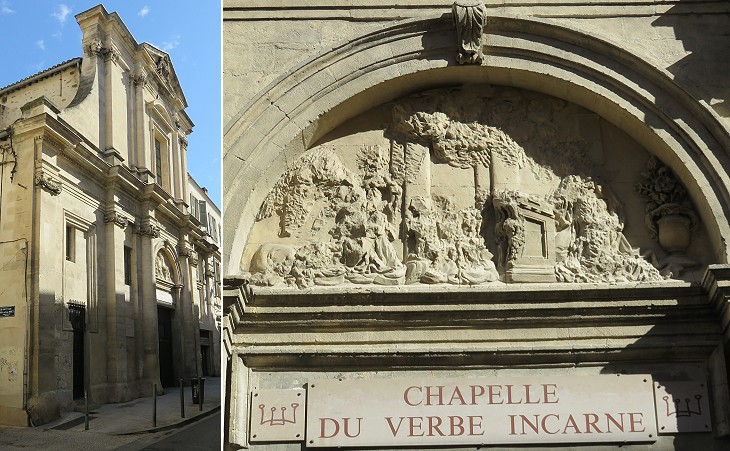
Church of the Order of the Incarnate Word: (left) façade; (right) hammered relief of an Annunciation
The streets are
old and very narrow, but tolerably clean, and shaded by awnings
stretched from house to house. Bright stuffs and handkerchiefs,
curiosities, ancient frames of carved wood, old chairs, ghostly
tables, saints, virgins, angels, and staring daubs of portraits,
being exposed for sale beneath, it was very quaint and lively.
Charles Dickens - Pictures from Italy - visit made in 1844
The account by Dickens indicates that even fifty years after the annexation of Avignon to France items from its many churches, monasteries and nunneries were on sale in its streets. The soldiers who destroyed all visible evidence of the false religion, including the relief shown above, stole and hid some of the holy objects they found inside churches with the aim of selling them when the Cult of Reason and that of the Supreme Being would have gone out of fashion.
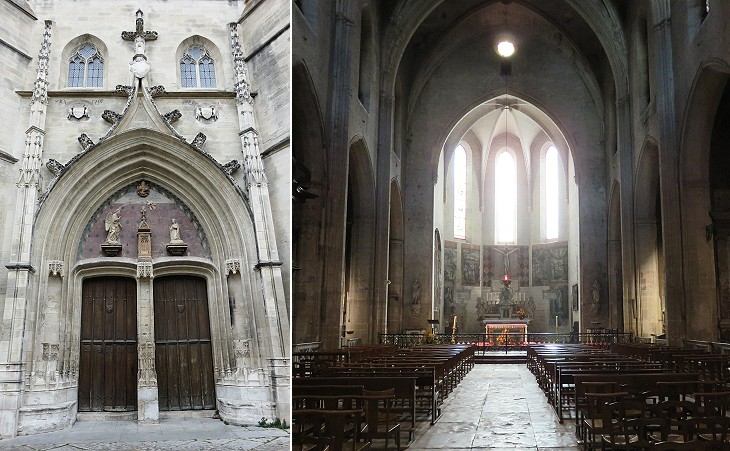
(left) Saint-Agricole: façade; (right) Saint-Didier: interior
There are four churches where religious service is performed: St Agricole, St Pierre, St Didier and the church des Carmes, but neither of these contain anything remarkable. Coxe
In 1801 an agreement between Pope Pius VII and Napoleon restored Catholic clergy and hierarchy in France, but the Roman Church never regained the power and status it had before the Revolution. The rules established in 1801 were not modified by the return of the French monarchy in 1814. They continued to be complied with until 1905 when a law emphasized the lay role of the State and caused the rupture of diplomatic relations between the Holy See and the French Republic until 1921. Because of these political events Avignon has a very high number of deconsecrated churches.
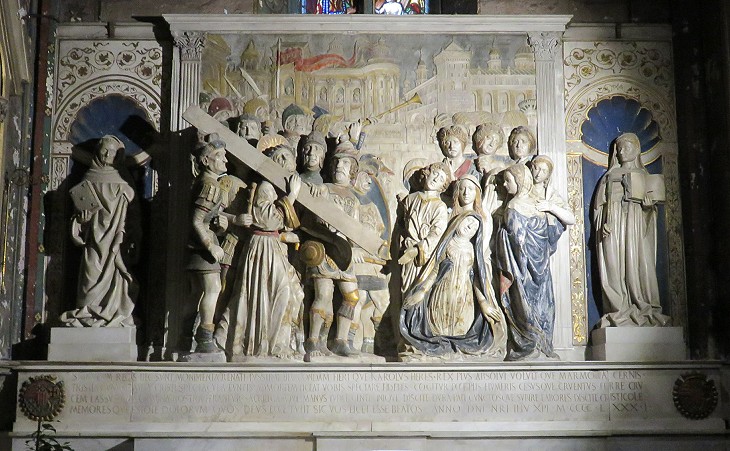
Saint-Didier: altarpiece formerly in the church of the Celestins
There are many sumptuous
churches (..) Clement VI. lies buried in that of the Celestines, the altar whereof is exceeding rich. Evelyn
The
church of the Celestins is a magnificent building,
in which there is a picture of the carrying of the
cross in Mosaic work, reckoned a master-piece in
its kind.
Thomas Nugent - The Grand Tour - 1749
The altarpiece was commissioned by Le Bon Roi René to Francesco Laurana, an Italian sculptor who extensively worked at Palermo after his stay at Avignon in 1461-1466. It is just one of the works of art which testify to the strong cultural links between Avignon and Italy. King René (1409-1480) of the House of Anjou Valois played a major role in the history of France, but also in those of Italy as King of Naples (1435-1442) and of Spain as King of Aragon (1466-1472). He was also Count of Provence, a fiefdom which originated from a partition of the Holy Roman Empire; in this capacity he ruled over the territory to the south of Avignon. He was a protector of the arts and a poet himself and this aspect of his life earned him the nickname of Bon Roi. He spent many years in the family palace/castle of Tarascon, another town on the left bank of the Rhône, south of Avignon.
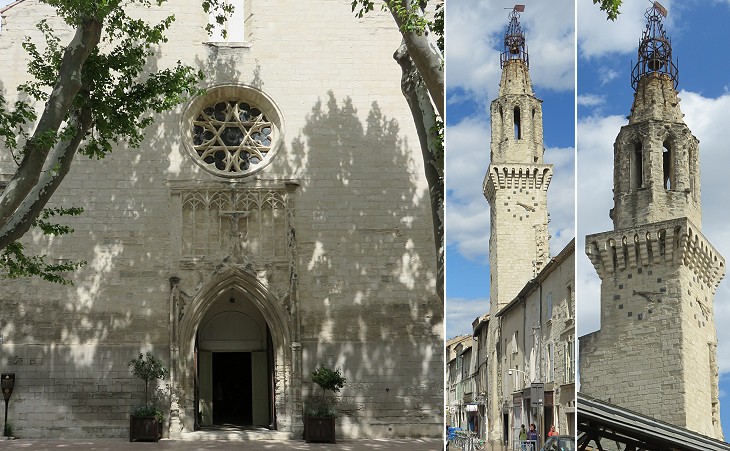
(left) Façade of Saint-Symphorien-les-Carmes; (right) bell tower of a lost Augustinian monastery
The Carmelites and the Augustinians had their monasteries side by side in an area which was outside the walls of Avignon which preceded those built by the Popes in 1356-1370. In the 1790s both monasteries were doomed to be demolished, but the Carmelite church was spared because it was chosen by the Jacobin Club (Society of the Friends of the Constitution) of Avignon for their meetings, similar to what they did at Toulouse. In 1803 it returned to be a church, but a parish one and it was dedicated to Saint Symphorien d'Autun, a IInd century martyr.
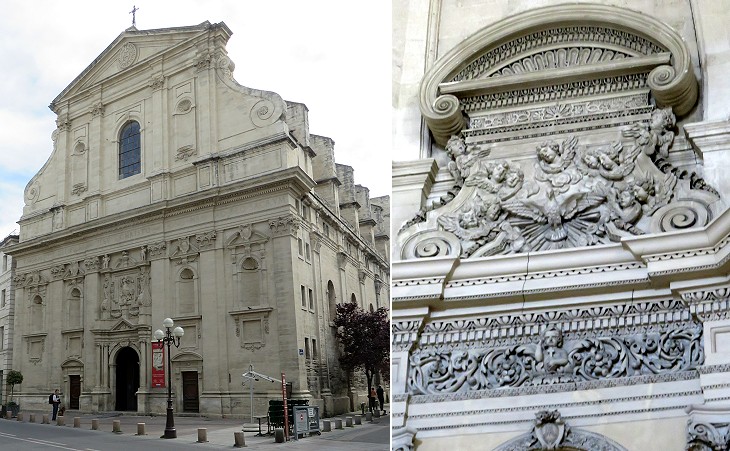
Jesuit Church: (left) façade; (right) detail of the interior
The Jesuits have two colleges both
of which are handsome buildings. Nugent
The churches of Avignon had some Gothic features well into the XVIth century. That of the College of the Jesuits marks a clear change; it was built in 1620 by Étienne Martellange, a Jesuit himself who agreed its design with the Roman headquarters of the Order and actually the church resembles Chiesa del Gesù. In line with the Jesuit tradition it was lavishly decorated, but only some stuccoes were spared during the many modifications the building underwent.
It now houses the Lapidary Museum of Avignon.
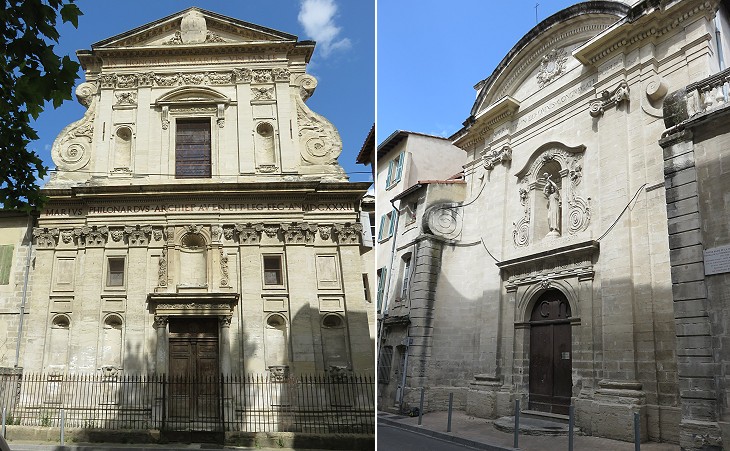
(left) Church of the Visitation of Mary; (right) adjoining chapel of the Conversion of Mary
Clergymen and friars swarm in the streets, as may
well be expected in this little Rome, but they
have not brought with them the Roman taste
in building and decorating either their own
abodes, or the temples of the divinity. Swinburne
After that of the Jesuits some other churches were built by local architects in a Roman fashion which included highlighting the name of the founder in large inscriptions similar to what popes and cardinals did in Rome.
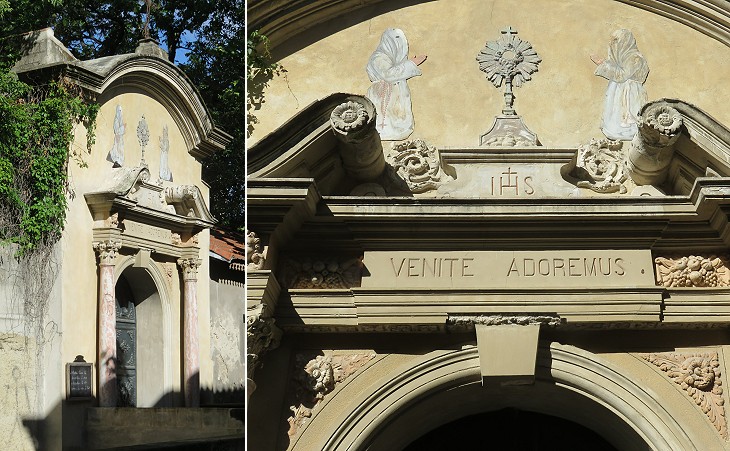
Chapelle des Pénitents-Gris: façade
A number of small churches were built by brotherhoods for their meetings and ceremonies, similar to what occurred in Rome. The oldest brotherhood of Avignon was founded at a very dramatic moment of the history of France. In 1209 a Crusade was called by Pope Innocent III against those who in Southern France had embraced the Cathar movement. A number of towns were seized and their inhabitants massacred, yet the heresy was not totally eradicated and a second crusade began in 1225. In June 1226 King Louis VIII of France asked to enter Avignon with his army; the inhabitants refused to surrender, but the town capitulated after three months on September 9. On September 14, Feast of the Cross, the King, wearing a gray garb and followed by his dignitaries, led a procession to a small chapel outside the walls of the town. A brotherhood (La Dévote et Royale Compagnie des Pénitents Gris d'Avignon) was founded on that occasion. King Louis VIII died of dysentery two months later at the age of 39. The brotherhood was disbanded in 1792, but it was reconstituted after 1814.
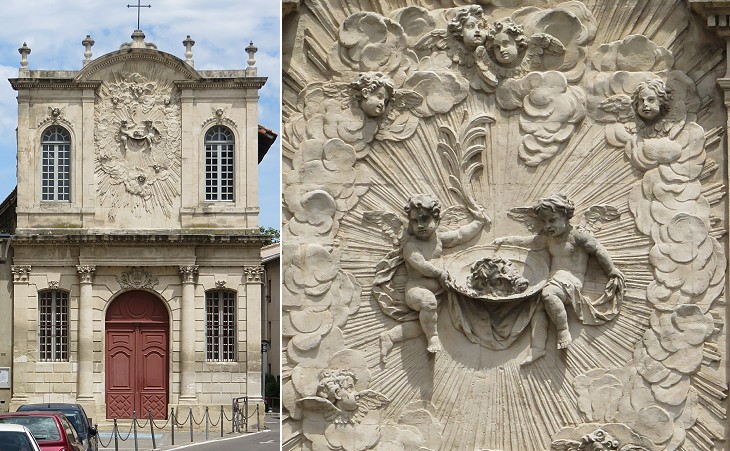
Chapelle des Pénitents-Noirs: (left) façade; (right) detail showing the head of St. John Baptist
In the XVth century Avignon housed a large community of Florentines, similar to Lyon. Among the names of the Florentine families living at Avignon one finds the Perussis (Peruzzi) and the Passis (Pazzi), who were forced out of Florence after a failed attempt to kill Lorenzo de' Medici. They formed a tight community and founded institutions to retain their bonds and culture. A brotherhood granted mutual help to its members and was dedicated to the patron saint of Florence, similar to what occurred in Rome. Eventually the brotherhood was enlarged to include a mixed membership, but it retained the reference to St. John Baptist. The façade of the chapel was designed in ca 1740 and the relief at its centre was spared in the 1790s perhaps because the members of the brotherhood managed to stress the charitable rather than religious nature of their activities.
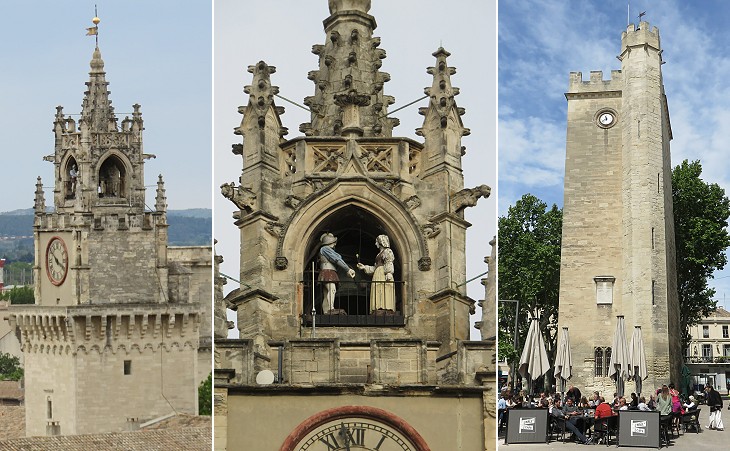
(left/centre) Livrée d'Albano and Tour de l'Horloge; (right) Tour Saint-Jean-Le-Vieux des Hospitaliers
The Place d' Horloge is overlooked by the clock tower or belfry called Jacquemart from the figure in armour who strikes the hours attached to the Hotel de Ville. Murray
The main palaces of Avignon are known as livrées (delivered) because they were assigned by the Popes to cardinals and other members of the court. The Livrée d'Albano is named after a Cardinal who was Bishop of Albano during the Great Schism. It was eventually turned into the Town Hall and a clock was placed on the top of its tower.
Tour Saint-Jean-Le-Vieux des Hospitaliers is named after an old hospital, but it was actually built by Cardinal Nicolas de Besse before he was elected Pope Gregory XI in 1370. His palace was known as Livrée de Florence because it became the residence of Cardinal Pietro Corsini, Bishop of Florence who died at Avignon in 1405. The building was demolished in the XIXth century, but the tower was spared.
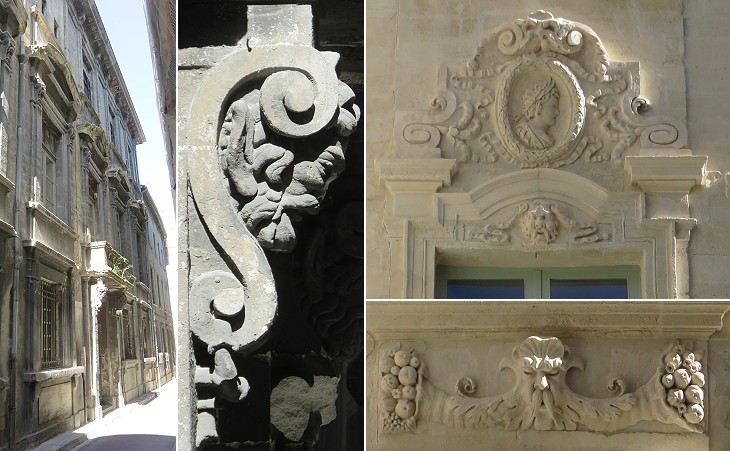
(left) Hotel Fortia de Montreal which was designed by François de Royers de La Valfenière in 1637; (centre) detail of the portal; (right) details of Hotel Bernard de Crillon
In the XVIIth century some of the old palaces of the cardinals were modified to adapt them to the new architectural style. Hotel Bernard de Crillon in particular brings to mind some Roman palaces in the large use of stuccoes depicting Roman emperors, e.g. Palazzo Spada, or other decorative patterns, e.g. masks, which were popular in Rome.
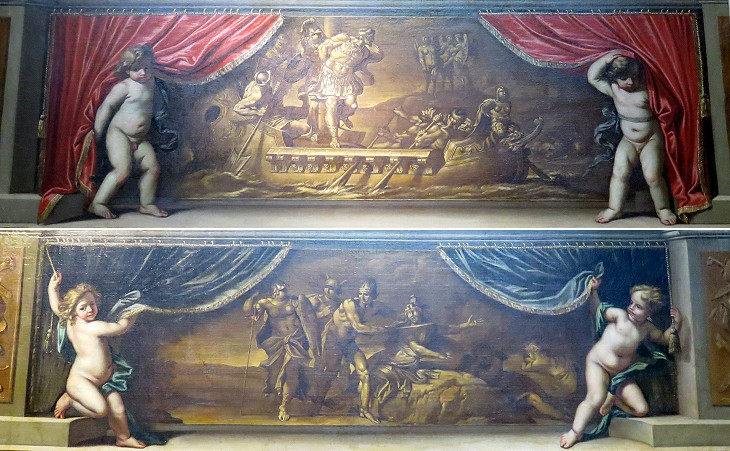
Lapidary Museum of Avignon: frescoes from Hotel Fortia: Ulysses and the Arpies (above - see this episode in a beautiful Roman mosaic in Tunisia) and Perseus killing Medusa (below - see some famous statues portraying Perseus with the head of Medusa)
Some palaces of Avignon were embellished with frescoes depicting mythological events. Hotel Fortia was decorated by Nicolas Mignard with 18 bronze-coloured monochrome frescoes very similar to those of the Papal Apartment at Castel Sant'Angelo. The painter spent two years in Rome where he worked as assistant of his brother Pierre who lived there in 1635-1657.
In 1774 Hotel Fortia was sold and the landlord detached Mignard's frescoes to sell them piecemeal; only two panels survived to the present day.
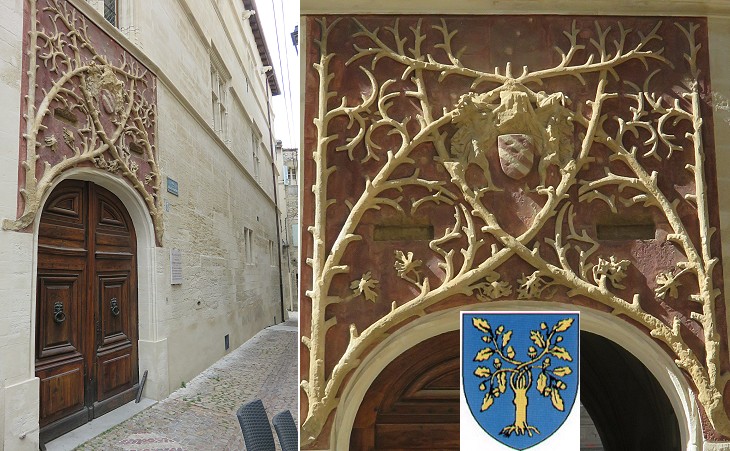
Hotel du Roure aka Hotel de Baroncelli-Javon and its portal; (inset) heraldic symbol of the della Rovere
The Baroncelli were one of the Florentine families who were exiled because of their involvement in the plot against the Medici. Bernardo Bandini Baroncelli was actually the killer of Giuliano de' Medici. Some members of the family already lived at Avignon where they became very rich also thanks to their friendship with Cardinal Giuliano della Rovere, Legate at Avignon (who became Pope Julius II in 1503). He was the nephew of Pope Sixtus IV, a great enemy of the Medici. The heraldic symbol of the della Rovere was a stylized sessile oak and decorative patterns based on oak branches can be seen in many monuments of the Della Rovere, e.g. at S. Maria della Querce. The branches on the portal of the Baroncelli palace are not exactly those of a sessile oak, the leaves resembling those of a fig tree, but the idea for this decoration most likely came from the della Rovere heraldic symbol.
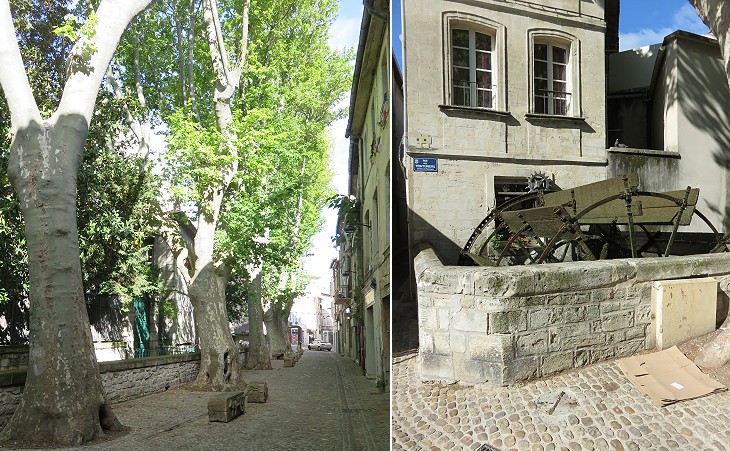
Rue des Teinturiers (dyers) and a mill which was activated by a branch of the Sorgue, a river which originates from the Fountain of Vaucluse
Avenio ventosa, sine vento venenosa, et cum vento fastidiosa (Avignon is windy, without wind venomous and with wind annoying). Some of the foreign travellers who visited Avignon quoted this saying and complained about the smell in some parts of the town; it was partly due to the printing of cotton fabrics in a poor neighbourhood near Chapelle des Pénitents-Gris. Today the area makes a pleasant addition to a walk away from the busy city centre.
Return to the main page.
Plan of this section:
Introductory page
Arles (Arelate)
Environs of Arles: Saint-Gilles, Aigues-Mortes and Saintes-Maries-de-la-Mer
Avignon (Avenio)
Carpentras (Carpentaracte), Cavaillon (Cabellio) and Pernes-les-Fontaines
Fontaine-de-Vaucluse and Le Thor
Glanum
Lyon (Lugdunum)
Marseille (Massilia)
Narbonne (Narbo Martius)
Nîmes (Nemausus)
Orange (Arausio)
Pont-du-Gard and Uzès
Saint-Bertrand-des-Comminges (Lugdunum Convenarum)
Tarascon (Tarasco)
Toulouse (Tolosa)
Vaison-la-Romaine (Vasio)
Vienne (Vienna)
Villeneuve-lez-Avignon

